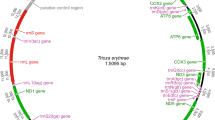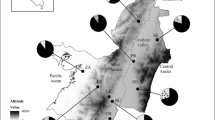Abstract
Thaumastocoris peregrinus Carpintero and Dellapé (Hemiptera: Thaumastocoridae) is a native Australian Eucalyptus sap-feeding insect that has become invasive and seriously damaging to commercially grown Eucalyptus in the Southern Hemisphere. Cleruchoides noackae Lin and Huber (Hymenoptera: Mymaridae) was recently discovered as an egg parasitoid of the Thaumastocoridae in Australia. Mitochondrial DNA (mtDNA; cytochrome c oxidase subunit I, COI) sequence diversity amongst 104 individuals from these native C. noackae populations revealed 24 sequence haplotypes. The COI haplotypes of individuals collected from the Sydney and Southeast Queensland clustered in distinct groups, indicating limited spread of the insect between the regions. Individuals collected from Perth in Western Australia were represented by four COI haplotypes. Although this population is geographically more isolated from other populations, two COI haplotypes were identical to haplotypes found in the Sydney region. The results suggest that C. noackae has recently been introduced into Perth, possibly from the Sydney area. The high mtDNA diversity and limited spread that is suggested for C. noackae is in contrast to the lack of geographic associated mtDNA diversity and extensive spread of T. peregrinus. If implemented as a biological control agent, this factor will need to be considered in collecting and releasing C. noackae.

Similar content being viewed by others
References
Angalet GW, Tropp JM, Eggert AN (1979) Coccinella septempunctata in the United States: recolonizations and notes on its ecology. Environ Entomol 8:896–901
Burgess T, Wingfield MJ (2002) Impact of fungal pathogens in natural forest ecosystems: a focus on Eucalyptus. In: Sivasithamparam K, Dixon KW, Barrett RL (eds) Microorganisms in plant conservation and biodiversity. Kluwer, Dordrecht, pp 285–306
Cai YW, Cheng XY, Xu RM, Duan DH, Kirkendall LR (2008) Genetic diversity and biogeography of red turpentine beetle Dendroctonus valens in its native and invasive regions. Insect Sci 15:291–301
Chen P, Ye H (2008) Relationship among five populations of Bactrocera dorsalis based on mitochondrial DNA sequences in western Yunnan China. J Appl Entomol 132:530–537
Clement M, Posada D, Crandall KA (2000) TCS: a computer program to estimate gene genealogies. Mol Ecol 9:1657–1660
Cognato AI (2006) Standard percent DNA sequence differences for insects does not predict species boundaries. J Econ Entomol 99:1037–1045
Darling JA, Blum MJ (2007) DNA-based methods for monitoring invasive species: a review and prospectus. Biol Invasions 9:751–765
Dasmahapatra KK, Mallet J (2006) DNA barcodes: recent successes and future prospects. Heredity 97:254–255
de León JH, Logarzo GA, Triapitsyn SV (2008) Molecular characterization of Gonatocerus tuberculifemur (Ogloblin) (Hymenoptera: Mymaridae), a prospective Homalodisca vitripennis (Germar) (Hemiptera: Cicadellidae) biological control candidate agent from South America: divergent clades. Bull Entomol Res 98:97–108
Excoffier L, Smouse P, Quattro J (1992) Analysis of molecular variance inferred from metric distances among DNA haplotypes: application to human mitochondrial DNA restriction data. Genetics 131:479–491
Excoffier L, Laval G, Schneider S (2005) Arlequin ver. 3.0: an integrated software package for population genetics data analysis. Evol Bioinform Online 1:47–50
Gariepy TD, Kuhlmann U, Gillott C, Erlandson M (2007) Parasitoids, predators and PCR: the use of diagnostic molecular markers in biological control of Arthropods. J Appl Entomol 131:225–240
Grevstad FS (1999) Factors influencing the chance of population establishment: implications for release strategies in biocontrol. Ecol Appl 9:1439–1447
Hebert PDN, Penton EH, Burns JM, Janzens DH, Hallwachs W (2004) Ten species in one: DNA barcoding reveals cryptic species in the neotropical skipper butterfly Astraptes fulgerator. Proc Natl Acad Sci USA 101:14812–14817
Hoelmer KA, Kirk AA (2005) Selecting arthropod biological control agents against arthropod pests: Can the science be improved to decrease the risk of releasing ineffective agents? Biol Control 34:255–264
Horn A, Roux-Morabito G, Lieutier F, Kerdelhue C (2006) Phylogeographic structure and past history of the circum-Mediterranean species Tomicus destruens Woll. (Coleoptera: Scolytinae). Mol Ecol 15:1603–1615
Hudson RR, Slatkin M, Maddison WP (1992) Estimation of levels of gene flow from DNA sequence data. Genetics 132:583–589
Hufbauer RA, Roderick GK (2005) Microevolution in biological control: mechanisms, patterns, and processes. Biol Control 35:227–239
Jacobs DH, Neser S (2005) Thaumastocoris australicus Kirkaldy (Heteroptera: Thaumastocoridae): a new insect arrival in South Africa, damaging to Eucalyptus trees. S Afr J Sci 101:233–236
Kimura M (1980) A simple method for estimating evolutionary rate of base substitution through comparative studies of nucleotide sequences. J Mol Evol 16:111–120
Lin N, Huber JT, La Salle J (2007) The Australian genera of Mymaridae (Hymenoptera: Chalcidoidea). Zootaxa 1596:3–111
Lloyd CJ, Hufbauer RA, Jackson A, Nissen SJ, Norton AP (2005) Pre- and post-introduction patterns in neutral genetic diversity in the leafy spurge gall midge, Spurgia capitigena (Bremi) (Diptera: Cecidomyiidae). Biol Control 33:153–164
Loch AD, Floyd RB (2001) Insect pests of Tasmanian blue gum, Eucalyptus globulus globulus, in south-western Australia: History, current perspectives and future prospects. Austral Ecol 26:458–466
Meier R, Zhang G, Ali F (2008) The use of mean instead of smallest interspecific distances exaggerates the size of the “barcoding gap” and leads to misidentification. Systematic Biol 57:809–813
Nadel RL, Slippers B, Scholes MC, Lawson SA, Noack AE, Wilcken CF, Bouvet JP, Wingfield MJ (2010) DNA bar-coding reveals source and patterns of Thaumastocoris peregrinus invasions in South Africa and South America. Biol Invasions 12:1067–1077
Nei M (1987) Molecular evolutionary genetics. Columbia University Press, New York
Noack AE (2002) Thaumastocoridae—an investigation. Retrieved from http://pandora.nla.gov.au/pan/32881/20030204/www.thaumastocoridae.org/index.html. Accessed 10 January 2009
Noack AE, Coviella CE (2006) Thaumastocoris australicus Kirkaldy (Hemiptera: Thaumastocoridae): first record of this invasive pest of Eucalyptus in the Americas. Gen Appl Entomol 35:13–15
Roderick GK (1996) Geographic structure of insect populations: gene flow, phylogeography, and their uses. Annu Rev Entomol 41:325–352
Roderick GK, Navajas M (2003) Genes in new environments: genetics and evolution in biological control. Nat Rev Genet 4:889–899
Rozas J, Sánchez-Delbarrio JC, Messeguer X, Rozas R (2003) DnaSP, DNA polymorphism analyses by the coalescent and other methods. Bioinformatics 19:2496–2497
Rozen S, Skaletsky HJ (2000) Primer3 on the WWW for general users and for biologist programmers. In: Krawetz S, Misener S (eds) Bioinformatics methods and protocols: methods in molecular biology. Humana, Totowa, NJ, pp 365–386
Sha Z, Zhu C, Murphy RW, La Salle J, Huang D (2006) Mitochondrial phylogeography of a leafminer parasitoid, Diglyphus isaea (Hymenoptera: Eulophidae) in China. Biol Control 38:380–389
Simon C, Frati F, Beckenbach A, Crespi B, Liu H, Flook P (1994) Evolution, weighting, and phylogenetic utility of mitochondrial gene sequences and a compilation of conserved polymerase chain reaction primers. Ann Entomol Soc Am 87:651–701
Tamura K, Dudley J, Nei M, Kumar S (2007) MEGA 4: Molecular Evolutionary Genetic Analysis (MEGA) software version 4.0. Mol Biol Evol 24:1596–1599
Vandewoestijne S, Baguette M, Brakefield PM, Saccheri IJ (2004) Phylogeography of Aglais urticae (Lepidoptera) based on DNA sequences of the mitochondrial COI gene and control region. Mol Phylogenet Evol 31:630–646
Vaughn TT, Antolin MF (1998) Population genetics of an opportunistic parasitoid in an agricultural landscape. Heredity 80:152–162
Acknowledgments
Members of the Tree Protection Co-operative Programme (TPCP), the Department of Trade and Industry THRIP programme and the National Research Foundation (NRF) are thanked for financial support.
Author information
Authors and Affiliations
Corresponding author
Additional information
Handling Editor: Torsten Meiners
Rights and permissions
About this article
Cite this article
Nadel, R.L., Wingfield, M.J., Scholes, M.C. et al. Mitochondrial DNA diversity of Cleruchoides noackae (Hymenoptera: Mymaridae): a potential biological control agent for Thaumastocoris peregrinus (Hemiptera: Thaumastocoridae). BioControl 57, 397–404 (2012). https://doi.org/10.1007/s10526-011-9409-z
Received:
Accepted:
Published:
Issue Date:
DOI: https://doi.org/10.1007/s10526-011-9409-z




